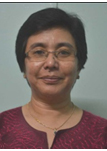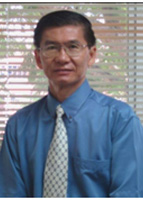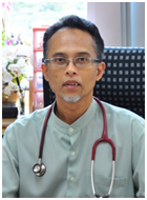Local Publications
The following publications used ISAAC data from the Kota Bharu centre:
- Quah BS, Wan-Pauzi I, Ariffin N, Mazidah AR. Prevalence of asthma, eczema and allergic rhinitis: Two surveys, 6 years apart, in Kota Bharu, Malaysia. Respirology 2005; 10(2):244-249.
- Quah BS, Razak AR, Hassan MH. Prevalence of asthma, rhinitis and eczema among schoolchildren in Kelantan, Malaysia. Acta Paediatr Jpn. 1997;39(3):329-35.
Kota Bharu Centre
| Phase OneView Centre Details | Phase Two | Phase Three | |||
| Centre: | Kota Bharu, Malaysia ( Asia-Pacific ) | ||||
| Principal Investigator: | Associate Professor Ban Seng Quah | ||||
| Age Groups: | 13-14, 6-7 | Timeframe: | July 2001 to August 2001 | ||
| Sampling Frame: | All schools under the Ministry of Education, Malaysia. Same sampling frame used for both Phase One and Phase Three. | ||||
Personnel
Personnel
Dr. Mazidah Abdul Rasid

Department of Paediatrics, School of Medical Sciences
Universiti Sains Malaysia,
16150 Kubang Kerian,
Kelantan
Malaysia
Roles:
- Phase Three collaborator for Kota Bharu
- Left Universiti Sains Malaysia in 2006 and is now working at Perdana Specialist Hospital, Jalan Bayam, 15200 Kota Bharu, Kelantan, Malaysia
Dr. Mohd Hashim Mohd Hassan
Department of Community Medicine
Universiti Sains Malaysia,
16150 Kubang Kerian,
Kelantan
Malaysia
Roles:
- Phase One collaborator for Kota Bharu
Dr. Ariffin Nasir
Department of Paediatrics, School of Medical Sciences
Universiti Sains Malaysia,
16150 Kubang Kerian,
Kelantan
Malaysia
Roles:
- Phase Three collaborator for Kota Bharu
Kol. (B) Dr. Wan Pauzi Wan Ibrahim

Department of Paediatrics, School of Medical Sciences
Universiti Sains Malaysia,
16150 Kubang Kerian,
Kelantan
Malaysia
Roles:
- Phase Three collaborator for Kota Bharu
Professor Ban Seng Quah

Department of Paediatrics, School of Medical Sciences
Universiti Sains Malaysia,
16150 Kubang Kerian,
Kelantan
Malaysia
Roles:
- Phase One Principal Investigator for Kota Bharu
- Phase Three Principal Investigator for Kota Bharu
- Left Universiti Sains Malaysia in 2010 and is now working at: Melaka-Manipal Medical College, Jalan Batu Hampar, Bukit Baru, 75150 Melaka, Malaysia
Dr. Abdul Razif Abdul Razak

Department of Community Medicine
Universiti Sains Malaysia,
16150 Kubang Kerian,
Kelantan
Malaysia
Roles:
- Phase One collaborator for Kota Bharu
- Left Universiti Sains Malaysia in 1996 and is now working at: Kedah Medical Centre, Pumpong, 05250 Alor Setar, Kedah Darul Aman, Malaysia
Why was this centre selected for ISAAC?
Kota Bharu, situated in the northeastern part of peninsula Malaysia is the state capital of Kelantan. We were invited to participate in ISAAC by the national coordinator Associate Professor Jessie de Bruyne. As there were no studies on the prevalence of asthma and allergic diseases from this region, we were very enthusiastic to be part of ISAAC. It was also an opportunity to compare the prevalence of the asthma, eczema and allergic rhinitis in Kota Bharu with the more affluent and urban population in the west coast of the peninsular. The demographics of this state is also very different from that in the west coast as 95% of the population are ethnic Malays.
Our experience of ISAAC
In this multiracial country, a major problem was preparing the ISAAC questionnaire in different languages. As the majority of the population in Kota Bharu are Malays, the ISAAC questionnaire was translated to Malay which is also the national language. The translation was successfully done with the help of Dr. Abdul Razif along with the assistance of language teachers from the university. Several meetings were held with the national coordinator to discuss the Malay questionnaire so that a similar questionnaire could be used in all ISAAC centres in Malaysia. We also needed a Mandarin questionnaire to be used for the few Chinese schools in Kota Bharu district. But this was a minor problem as we adopted the Mandarin questionnaire from our colleagues in Singapore.
Permission from the Kelantan State Director of Education was obtained to conduct the surveys in the schools. We did not face any barriers during our visits to the schools and the teachers assisted by arranging a suitable venue for the video questionnaire. Logistically, it was not a difficult survey to carry out as the permission from the State Director of Education ensured that the students and teachers fulfilled our requests. This might explain the high rate of response of our questionnaires. The response rate for the written questionnaires was also surprisingly high which could be a reflection of the interest of parents.
Acknowledgements
We wish to thank Universiti Sains Malaysia for providing research grants, and also the Ministry of Education, Malaysia, for granting permission to perform both Phase One and Three surveys among school children in Kota Bharu district. We are also indebted to all children, parents and school staff who participated in the surveys.
